Out in the mallee country a little Aussie bird is doing the
impossible. It's shifting literally tonnes and tonnes of dirt, all in the name
of making babies.
By Janet Parker
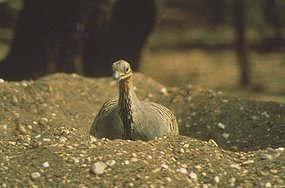
A malleefowl on its nest (Source:
David Priddel/)
The challenge for the Malleefowl is to keep their eggs at a
constant temperature. They do it the hard way, by building a mansion in the
mallee that acts as a giant incubator, and then furiously adding or removing
sand as the temperature varies.
Around October, the female malleefowl starts to lay her eggs. She lays one
egg every 4 to 8 days and continues laying until January. While the female is
busy laying the eggs, the male's job is keeping the nest at the right incubation
temperature, about 33C, by shifting dirt.
These birds believe that 'big is best'. Their nest looks like a strange
miniature volcano, but is really a mound of dirt, a do-it-yourself incubator
that stands at an incredible one metre high and occupies an area up to 12 metres
wide.
What is mallee?
"The mallee" is country dominated by shrub-like, multi-stemmed mallee
eucalypts and remnant pockets of it can be found in Australia's arid and
semi-arid zone. Malleefowl can also be found hanging out in Broombush
communities, or Callitris woodlands, Mulga scrublands and in western Australia's
coastal heaths.
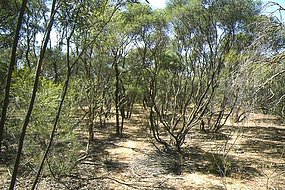
Mallee country (Source: David Priddel/)
Thousands of years ago this bird lived in the rainforest, where incubating
eggs was an easier task, but as the Australian continent slowly dried, the
malleefowl has had to adapt to living in a much harsher and drier
environment.
Australia's bigfoot
Malleefowl belong to the family Megapodiidae, meaning big footed, a
useful feature, given the way they build their nests. Megapodes are the only
birds that bury their eggs and then incubate them using external sources of
heat, such as decomposing vegetation, or solar radiation. In Indonesia, one
megapode uses sands warmed by volcanic activity.
There are 22 other species of megapodes in the world but Australia's
malleefowl is the only one adapted to arid habitats. The others live mostly in
moist tropical rainforest. Australia has two other megapodes ? the
Australian brush-turkey (Alectura lathami) and the Scrubfowl
(Megapodius reinwardt), both of which live in rainforest.
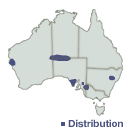
Fact file:
When: October
Where: Mallee country of NSW, VIC, WA and SA
Native pheasant for dinner?
Malleefowl look like big chooks. Once they were very widespread across
southern and central Australia in every state except Queensland. In the 19th and
early 20th centuries they were so common that white settlers often shot them for
food. The Australian section of Mrs Beeton's famous cookbook includes a recipe
for roast malleefowl. Settlers called them mallee hen or native pheasant.
Aboriginal Australians also used to regularly raid malleefowl nests for the
eggs. There are many Aboriginal names for the bird including gnow, ngow,
ngow-o, ngow-o-ou, nganamara, ngamara, marrakko or marra-ko.
Today the mallee fowl is in trouble. It's estimated that their numbers are
only 20 per cent of what they were before European settlement. Their range and
distribution have also decreased. Up to 1981, surveys had recorded mallee fowl
in 166 areas (an 'area' is a one degree by one degree grid cell). Since 1981
they've only been recorded in 81 of those areas. In other words, malleefowl have
vanished from 50 per cent of their range.
Mallee love-mansions
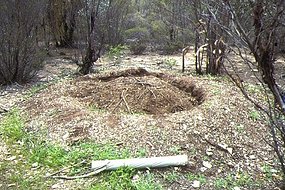
Malleefowl nest (Source: David Priddel/)
Malleefowls form long bonds, probably for life, and each pair occupies a
permanent territory. The male malleefowl spends 9 to11 months constructing and
maintaining the nest mound. At first the female helps as well, but when she
begins laying, she concentrates on searching for food. Each egg that she lays
weighs an incredible 10% of her bodyweight!
The malleefowl couple begin their nest in autumn. First they dig a crater
about one metre deep and four metres in diameter. On the right soil, the nest
can be up to 12 metres in diameter. Then during the winter they scrape up leaf
litter, twigs and bark, pile it into the hole and wait for rain to wet it.
In spring the birds dig a hole around half a metre in diameter and almost as
deep, in the top of the leaf litter. This will be the egg chamber. They scratch
a layer of loose soil to insulate the decomposing leaf litter. Preparing the
mound for laying takes up to four months and if it's a dry spring many nests are
abandoned before egg laying begins!
Both the male and female roost in nearby trees (though not in the same tree).
The female lays an egg about every six days. She usually visits the nest in the
first hour after dawn, often around sunrise.
Malleefowl eggs have a very long incubation period, 64 days or longer (emu
eggs only take 56 days). The chicks generally start hatching in December and can
continue until March.
Keeping things just right is hard work

Malleefowl nest with onlookers (Source: David
Priddel/)
The ideal temperature for the eggs is 33°C and for the next few months the
male malleefowl will go to extraordinary lengths to control the temperature in
the mound.
At first, in spring, the temperature from the rotting vegetation can become
too high so around dawn the male digs down to just a few centimeters from the
eggs, and allows excess heat to escape. Then he refills the hole with the cool
sand.
In late spring the heat from the decomposing leaves starts to wane, so the
nest only needs to be opened every few days.
By summer the sun's heat has greatly increased. The malleefowl now adds more
and more sand to the mound to insulate the eggs from the sun.
When the whole mound begins to heat up, the male uses the cooler morning
temperatures to his advantage. He removes the sand in the morning and scatters
it in the cool air. When the sand's cooled he piles it back on the mound before
the day gets hot.
In autumn, the heat from the core of decomposing vegetation starts to wane
and milder weather means that the mound temperatures can start to fall. The
malleefowl then uses the hottest part of the day to his advantage. In the
morning he digs almost all the soil away and spreads the soil out to be warmed
by the sun. Once it's warm he works furiously to return the sand to the
mound.
The temperature is judged by the male putting his head into the mound. He
first pecks rapidly once or twice, then drives his partly open bill into the
sand up to his eyes for a few seconds. It's thought he tests the temperature
with his tongue.
Parent-free zone
In 1840 John Gould gave malleefowl the name Leipoa ocellata ('the
spotted egg-leaver'), a good description of both its speckled appearance and the
fact that once the chicks hatch from the malleefowl's amazing nest, they're
completely left to their own devices.
The eggs are quite large, about 170 grams and their long incubation period
means the chicks are well developed when they hatch. They can fly within a few
hours and run and feed independently. A good thing given they spend about 15
hours struggling out of the nest mound, and receive no parental care at all.
Malleefowl know a thing or two about breeding. Their potential reproductive
rate is one of the highest of all bird species. In a good season the average egg
clutch size is about 16. From this each pair produces an average of 10 offspring
a year. Malleefowl breed for at least 10 years, so only two per cent of the
offspring need to survive to keep the population stable.
This breeding strategy allows for high mortality but even that might not be
enough.
Threats to the malleefowl's survival
The malleefowl succeeded in adapting to a harsh dry environment but it's not
been so lucky coping with European settlement and the pests and changes in land
management they brought with them.
In NSW it's classifed as endangered. In Victoria, South Australia and Western
Australia it's listed as vulnerable. It's also listed nationally as vulnerable
by the Commonwealth Government under the Environment Protection and Biodiversity
Conservation Act. A National Recovery Plan is about to be published.
Landclearing
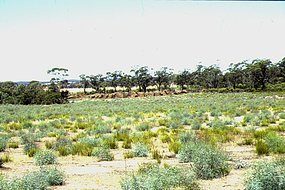
Cleared mallee lands (Source: David Priddel/)
The Malleefowl's habitat is fast disappearing. Mallee lands have already been
extensively cleared to grow wheat and graze sheep. Remaining mallee patches in
the wheatbelt are mostly small and very fragmented.
Many populations of malleefowl are isolated from other suitable habitat. This
fragmentation is a real problem for young malleefowl looking for new territory
away from their parent's. Malleefowl are poor fliers. They move about mostly on
foot. Also they depend on light tree cover for camoflauge and don't like moving
into open country where they're an easy catch for birds of prey.
Where larger tracts of mallee remain, they're often in areas unsuitable for
agriculture and so are often of marginal quality for malleefowl too.
Pastoralism
Grazing by sheep also seriously diminishes the quality of the habitat for
malleefowl. In areas grazed by sheep, malleefowl densities were only nine to 16
per cent of those in similar habitats free of stock. Rabbits and goats probably
have similar impacts. In NSW the majority of remaining mallee habitat is
currently under pastoral leasehold, most of which is subject to grazing by
stock.
Fires
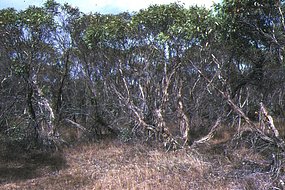
Old mallee lands (Source: David Priddel/)
Frequent fires and extensive fires are a significant threat to malleefowl
populations.
The trouble is these birds are fussy about their mallee. They particularly
like old mallee that hasn't been burnt for a long time and very little old
mallee still exists. Most mallee in Australia is only about 10-years-old.
Malleefowl rarely breed in habitat that's been burnt within the last 15 years,
and the greatest densities of birds occur in mallee that hasn't been burnt for
several decades. They like a good canopy of trees which give the dappled light
in which they're best camoflauged.
Frequent burning can more than double the productivity of pastoral mallee
habitats for sheep and so some mallee under leasehold was regularly burnt on a
10?20 year cycle to increase forage production, eliminate shrubs that sheep
don't eat and for fuel reduction. Broadscale burning used to be promoted by
government agricultural advisors.
Large fires also probably kill most malleefowl, who are unable to disperse
quickly and may make the bird locally extinct if an entire habitat patch is
burnt and there are no birds in surrounding areas to re-colonise the area.
Patchy burns are much less damaging to them.
Foxes
Foxes are a disaster for malleefowl. National Parks & Wildlife scientist
David Priddel believes foxes are currently the most significant threat to the
continued survival of malleefowl in NSW. They eat the eggs, chicks, sub-adults
and adults. In some areas they've been known to eat more than a third of all the
eggs laid.
David Priddel and Robert Wheeler's research has shown that fox predation on
malleefowl chicks is the greatest cause of their mortality. In an experiment at
Yathong Nature Reserve, about 160 km south of Cobar in western NSW, they
released young captive reared birds into areas with small numbers of resident
malleefowl, and found 50 per cent died within one week and none were still alive
after three months. Over 50% were killed by foxes.
David Priddel and his team have introduced an intensive fox baiting scheme,
and encouraged neighbouring landowners to do the same. They now have results
where 75 per cent of the released birds are alive six months after hatching.
Where are they now?
Malleefowl can still be found in many spots in southern Australia.
In NSW, the Western Plains Zoo at Dubbo has a captive colony of 12 malleefowl
pairs and a number of active mounds. Together with NSW Parks and Wildlife they
run a captive breeding program and for several years have released malleefowl
into the Yathong Reserve, near Cobar. This year 75 new malleefowl will be
released.
Malleefowl don't breed until they're about four years old, so the success of
the program won't be known for several years.
In South Australia, there are malleefowl in the Bookmark Biosphere Reserve
north of Berri, the Anangu Pitjanjatjara Lands in the north of the state, parts
of the Eyre Paninsula and in fragmented mallee south of the Murray River in
places like Gum Lagoon Conservation and Messent Conservation Park.
In Western Australia, malleefowl are found throughout the agricultural region
in the south-west. There's also a captive breeding and release program based at
Francois Peron National Park.
Scientists and community groups carry out yearly surveys of malleefowl
numbers around Dalwallinu and Morowa north of Perth, Ongerup in the South East
and Lake Magenta, near Newdegate and the Kalgoolie goldfields.
In Victoria, the main areas are the remaining big mallee blocks in the north
west of the state: Murray Sunset National Park and Hattah Lakes National Park;
the Big Desert area including Wyperfeld National Park; and the Little Desert
National Park. There are small populations on mallee fragments near the
parks.
References
- D. Priddel and R.Wheeler. "The biology and management of the Malleefowl
(Leippoa ocellata) in NSW." Species Management Report Number 19,
National Parks and Wildlife Service.
- D, Priddel & R. Wheeler. Malleefowl Conservation in New South Wales: a
review. Proceedings of the Third International Megapode Symposium,
Nhill, Australia, December 1997. (R.W. Drekker, D.N. Jones & J.
Benshemesh (eds)
- J. Benshemesh. "The National Malleefowl Recovery Plan: a framework for
conserving the species across Australia". Proceedings of the Third
International Megapode Symposium, Nhill, Australia, December 1997. (R.W.
Drekker, D.N. Jones & J. Benshemesh (eds)
- Around the Mounds, Volume 3, No.2, April 1999 and Volume 4, No.2
August 2000
- Towhidi Juliet, "A Helping Hand for the Big footed Battle with Built-In
'Thermometer'", Geo Australasia, May/June96, Vol. 18 Issue 3,
p58

